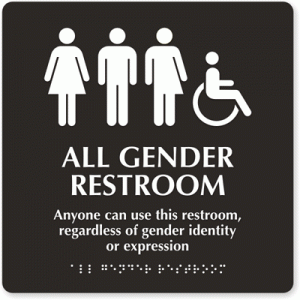The Transgender Right to Equal Access to Public Restrooms
 As a therapist I’m able to balance being compassionate yet maintain neutrality with my clients. But when I hear stories about how my transgender clients struggle to be able to use public restrooms and restrooms at their places of work, I’m unable to remain unaffected by this.
As a therapist I’m able to balance being compassionate yet maintain neutrality with my clients. But when I hear stories about how my transgender clients struggle to be able to use public restrooms and restrooms at their places of work, I’m unable to remain unaffected by this.
We’re talking about something that those who are cisgender constantly take for granted. I’d say nearly 100% of my transgender clients have experienced issues with using public and workplace restrooms. I now find it impossible to walk into one without reminding myself in that moment what a scary – yes scary – experience it can be for so many people who are transgender.
Think I’m being dramatic? This is from a recent study published by the Williams Institute, which surveyed transgender or gender non-conforming/genderqueer persons in the Washington, DC area:
70% of those surveyed had experienced some sort of negative reaction when using a bathroom.
68% reported they were told they were in the wrong facility, told to leave the facility, questioned about their gender, ridiculed or made fun of, verbally threatened, or stared at and given strange looks.
For 9% of respondents, actual physical assault has also occurred, including being forcibly removed from the restroom, hit or kicked, intimidated or cornered, or slapped; one respondent reported being sexually assaulted.
18% of respondents reported they were simply denied access to a restroom.
As many as 58% have avoided going out in public at times because of bathroom concerns.
54% reporting physical complications like dehydration, urinary tract infections, kidney infections, and other kidney problems simply because of the tactics they used to avoid going to the restroom during the day.
These findings are tragically being repeated all over the country, and my clients’ stories are a harsh reminder of this reality.
It’s insulting this even has to be a topic of discussion. We’re talking about the right for anyone to be able to safely use a public restroom to relieve one’s self. Something that is a biological necessity, an act that should be allowed to remain private, routine, and quite unremarkable in the grand scheme of things.
And yet it’s a fact that many transgender persons experience discomfort, anxiety, and fear when deciding whether or not they should attempt to use a public restroom.
There are many arguments against allowing transgender persons to use the restroom of their true gender identity. I’m not going to waste any time discussing them here because frankly I find them unfounded, presumptuous, and oftentimes based in transphobia.
What we can do is work together to create a future in which people who are transgender will no longer have to struggle with this issue. This is not an impossible task.
Let us not forget that once upon a time the restrooms, water fountains, public transportation, and restaurants in America were segregated into “whites” and “colored” because of a belief that people who were colored carried diseases and would contaminate the whites. The 1964 Civil Rights Act was the piece of legislation that made this illegal, and even then it took years before it was taken seriously by the citizens of this country.
In 2012 Joe Biden said that transgender discrimination is the “civil rights issue of our time.” It starts with people like us who know these atrocities exist, and then we do something about it.
Homework Assignment
If you are a business owner, consider implementing gender-neutral restrooms in your workplace. You can find tips on how to do so in the guide Peeing in Peace: A Resource Guide for Transgender Activists and Allies.
If you are the manager of a business that is part of a corporation and are unable to make this sort of change at your workplace, inform your employees that they are to respect and advocate for anyone who is transgender who uses your public restrooms.
Also, you can order all gender bathroom signs by clicking here.
If you are a patron of a business and want to approach the manager about changing their restroom to gender-neutral, turn again to the Peeing in Peace document, where step-by-step instructions are given as to how to handle that process.
If you have a friend or colleague who is transgender, offer to go with them to the restroom if they are feeling reluctant to do so (i.e. the “Buddy System”). Speak up if you hear someone make an unnecessary comment. An example of a response can be, “Excuse me, but my friend is just trying to use the bathroom – do you mind?”
Show support towards legislation that would offer protections to people who are transgender. An example of this would be the Colorado Anti-Discrimination Act. Since I practice in Colorado I make sure all of my transgender clients are aware of how they are protected in our state. The law includes language such as:
Just as non-transgender individuals should be able to use a restroom or locker room appropriate to their gender identity without having to provide documentation or respond to invasive requests, transgender individuals must also be allowed to use a gender-segregated facility appropriate to their transgender status without being harassed or questioned.
Additional Reading:
Transgender People Need Safe Restrooms by Masen Davis, Executive Director, Transgender Law Center
Equal Access to Bathrooms for Transgender People: the Myths & Truths by Dara Hoffman-Fox, LPC







Feminism and Identity – Queerly Texan
December 14, 2016 at 6:15 AM[…] (PHOTO CRED) […]